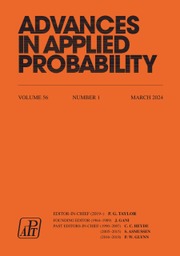Article contents
Expected coalescence time for a nonuniform allocation process
Published online by Cambridge University Press: 01 July 2016
Abstract
We study a process where balls are repeatedly thrown into n boxes independently according to some probability distribution p . We start with n balls, and at each step, all balls landing in the same box are fused into a single ball; the process terminates when there is only one ball left (coalescence). Let c := ∑j p j 2, the collision probability of two fixed balls. We show that the expected coalescence time is asymptotically 2c −1, under two constraints on p that exclude a thin set of distributions p . One of the constraints is c = o(ln−2 n). This ln−2 n is shown to be a threshold value: for c = ω(ln−2 n), there exists p with c(p ) = c such that the expected coalescence time far exceeds c −1. Connections to coalescent processes in population biology and theoretical computer science are discussed.
Keywords
Information
- Type
- General Applied Probability
- Information
- Copyright
- Copyright © Applied Probability Trust 2008
References
- 3
- Cited by

